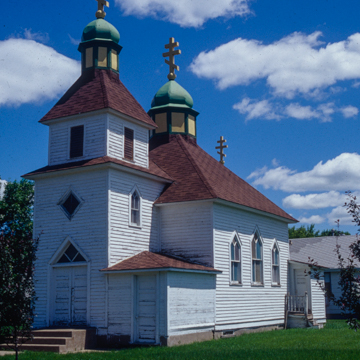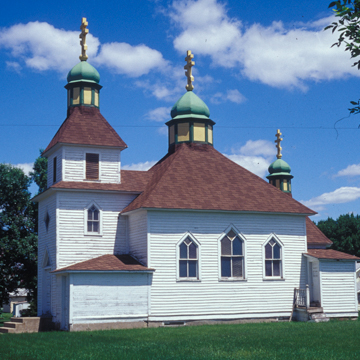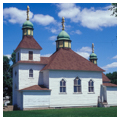This church represents a small group of Ukrainians who emigrated in 1897 from the area of Galicia in eastern Europe to homestead and work in the nearby lignite mines. In a region where Western Christian architectural forms predominate, Holy Trinity’s plan and its traditional colorful interior make it an exceptional building. It is one of only three Ukrainian Greek Orthodox churches in the state. The church has three distinct parts, reflecting the sequence of bell tower, nave, and apse. Onion-shaped (lukovitsa) domes of metal atop octagonal wooden drums crown each of three hipped-pyramid roof components of the church. Each dome supports a smaller one that serves as a base for each of three Russian tri-barred crosses. (In German Russian and German Hungarian cemeteries in western North Dakota, the oblique lower bar of the cross is often represented by a small ladder, invoking Christ’s descent from the cross.) The domes and drum mullions are painted green, and the drum panels and crosses are a faded gold. Except for more recent pews, the church interior is original. The nave ceiling and walls above the wainscoting are finished in a variety of pressed-metal patterns painted a light bright blue. The ceiling follows the contours of the truncated pyramidal-hipped roof, adding a dimension of spaciousness to the nave.
Holy Trinity Church embodies the diversity of religious expression in North Dakota. It is one of three original Ukrainian Greek Orthodox churches—Sts. Peter and Paul Church (SK11) in Belfield and Korsun/St. Pokrova (1919; inaccessible) in rural Dunn County are the others—but none of them has a viable congregation today. Holy Trinity occasionally recruits a pastor from Minneapolis for special baptismal, funeral, nuptial, and holy day events. The congregants have, however, been able to preserve the church as a symbol of cultural distinction and religious faith.





